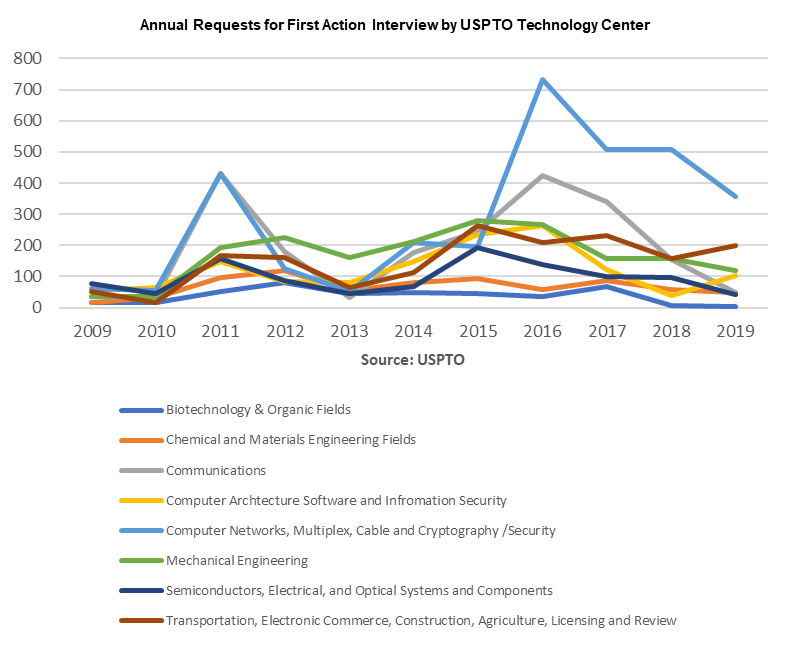By Tia Brand
Since its inception in 2008, the First Action Interview (FAI) Pilot Program has been hailed as an efficiency booster, increasing face time with examiners and potentially decreasing the number of office actions per application. Numerous articles, blog posts and the USPTO itself have maintained that the program increases the rate of first action allowance, boosts total rates of allowance over a 5-year period from the filing date, and decreases total prosecution time compared to applications which do not take advantage of the FAI program. All these things logically translate to decreased prosecution costs and happier clients, so why do few applicants take advantage of this fee-free program?

Despite a drastic decrease in 2013 and the subtler usage decrease in 2018, FAI program usage has trended up during the past 10 years, with the 510 total FAI requests filed in 2008 more than doubling to over 1100 FAI requests in 2018. However, this is still a small percentage of the nearly 300,000 original utility applications filed in the US each year.
The First Action Interview program has been available to all art units since the Full Pilot Program was introduced in 2011, yet there are some tech areas, most notably Biotechnology & Organic (1600) and Chemical and Materials Engineering (1700), where the FAI program is hardly being used at all. Upon implementation of the Full Pilot Program in 2011, all technology centers saw an uptick in FAI filings, led by Computer Networks, Multiplex, Cable and Cryptography/Security (2400) and Communications (2600). However, in 2013 Mechanical Engineering (3700) was the only tech center with over 100 FAI requests. It would be interesting to review changes in patent law during calendar years 2012-2013 to determine the cause of this drastic decrease in FAI requests across all technologies.

After the decline in 2013, FAI filings tended to increase for every technology area through 2016, with Computer Networks, Multiplex, Cable and Cryptography/Security (2400) and Communications (2600) again seeing the most impressive number of FAI filings. In 2016, Chemical and Materials Engineering (1700) and Biotechnology & Organic remained the tech areas with lowest FAI program usage. In recent years, Computer Networks, Multiplex, Cable and Cryptography/Security (2400) has continued to dominate FAI usage, with Communications (2600) dropping to near the bottom of the pack and all other areas maintaining, at best, modest FAI Program usage.
Despite promising reports on benefits of the First Action Interview (FAI) Pilot Program, most applicants, especially those in the Chemical and Biological fields, are not taking advantage of the tool 10 years after its original introduction to the public. The reason for this may simply be due to lack of knowledge surrounding the First Action Interview process or total unfamiliarity with the existence of the program. Moving forward, applicants should consider using the FAI Pilot Program in order to decrease prosecution time and costs. Detailed information regarding filing requirements for FAI requests can be found in the USPTO Official Gazette.






